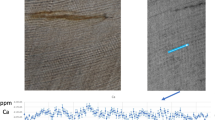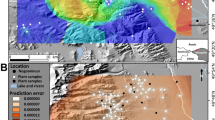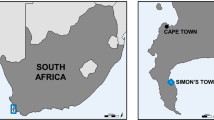Abstract
Radiogenic strontium isotopes (87Sr/86Sr) and the alkaline earth ratios (AERs) Sr/Ca and Ba/Ca in fossil dental enamel can inform the habitat, residence and life histories of early hominins recovered from the Pleistocene cradle-of-humankind sites of Gauteng, South Africa. Key questions, which may be addressed with these indices, are the relative exploitation of wet versus dry botanic regimes and whether early hominins dispersed in a manner similar to that of chimpanzees (characterized by male philopatry and female dispersal at puberty) or to that of humans (who are not so characterized). Here we developed 28 new dental chronologies in 20 Paranthropus robustus teeth from Swartkrans and Kromdraai. Resulting geochemical time series demonstrate that, while maternal 87Sr/86Sr in earlier-forming teeth varies widely, third molar 87Sr/86Sr, derived from postweaning solid foods, progressively converges to 0.7306 ± 0.0035 (± 2 s.d.), which we express as the local isotopically delineated exploitation area (LIDEA). The spatial resolution of LIDEA is determined using a bioavailable 87Sr/86Sr isoscape. In this environmental context, we interpret LIDEA as a quantifiable signal indicating eurytopy (generalization), with some 30% of Sr deriving from riparian woodland habitats. With regard to residence, many individuals arrived at the site after second molar mineralization, while some matured locally, demonstrating both male and female dispersal as well as lifelong local residence. Analysis of both 87Sr/86Sr and the AERs further highlights concomitant patterns, as well as numerous periodicities that may be related to resource depletion, seasonality or lunar cycles.
This is a preview of subscription content, access via your institution
Access options
Access Nature and 54 other Nature Portfolio journals
Get Nature+, our best-value online-access subscription
$32.99 / 30 days
cancel any time
Subscribe to this journal
Receive 12 digital issues and online access to articles
$119.00 per year
only $9.92 per issue
Buy this article
- Purchase on SpringerLink
- Instant access to full article PDF
Prices may be subject to local taxes which are calculated during checkout




Similar content being viewed by others
Data availability
Raw data are available on Zenodo at https://doi.org/10.5281/zenodo.14497676 (ref. 50), resampled data are available on Zenodo at https://doi.org/10.5281/zenodo.14355254 (ref. 51), final data are available on Zenodo at https://doi.org/10.5281/zenodo.14363950 (ref. 52) and input data for the isoscape calculation are available on Zenodo at https://doi.org/10.5281/zenodo.15496905 (ref. 54).
Code availability
All links to relevant R scripts are available on Zenodo at https://doi.org/10.5281/zenodo.15497667 (ref. 53).
Change history
11 August 2025
In the version of this article initially published, there was a citation error in the Fig. 1d caption where, in the sentence now reading "Data from ref. 9", ref. 11 was cited initially. The legend is updated in the HTML and PDF versions of the article.
References
Sillen, A., Hall, G. & Armstrong, R. Strontium calcium ratios (Sr/Ca) and strontium isotopic ratios (87Sr/86Sr) of Australopithecus robustus and Homo sp. from Swartkrans. J. Hum. Evol. 28, 277–285 (1995).
Copeland, S. R. et al. Strontium isotope evidence for landscape use by early hominins. Nature 474, 76–78 (2011).
Balter, V., Braga, J., Télouk, P. & Thackeray, J. F. Evidence for dietary change but not landscape use in South African early hominins. Nature 489, 558–560 (2012).
Sillen, A. & Balter, V. Strontium isotopic aspects of Paranthropus robustus teeth; implications for habitat, residence, and growth. J. Hum. Evol. 114, 118–130 (2018).
Hamilton, M. I., Copeland, S. R. & Nelson, S. V. A reanalysis of strontium isotope ratios as indicators of dispersal in South African hominins. J. Hum. Evol. 187, 103480 (2024).
Brain, C. K. The Hunters or the Hunted? An Introduction to African Cave Taphonomy (Univ. Chicago Press, 1981).
Bredenkamp, G. J. & Brown, L. R. A reappraisal of Acocks’ bankenveld: origin and diversity of vegetation types. S. Afr. J. Bot. 69, 7–26 (2003).
Hall, G. A Background Investigation into the Feasibility of Heavy Stable Isotopes (87Sr/86Sr) as Source Tracers of Early Hominids. MSc thesis, Univ. Cape Town (1995).
Sillen, A., Hall, G., Richardson, S. & Armstrong, R. 87Sr/86Sr ratios in modern and fossil food-webs of the Sterkfontein Valley: implications for early hominid habitat preference. Geochim. Cosmochim. Acta 62, 2463–2473 (1998).
Peters, C. R. & Maguire, B. Wild plant foods of the Makapansgat area: a modern ecosystems analogue for Australopithecus africanus adaptations. J. Hum. Evol. 10, 565–583 (1981).
Lee-Thorp, J. A., Sponheimer, M. & Luyt, J. Tracking changing environments using stable carbon isotopes in fossil tooth enamel: an example from the South African hominin sites. J. Hum. Evol. 53, 595–601 (2007).
Robinson, J. T. in African Ecology and Human Evolution (eds Bourliere, F. & Howell, C. F.) 385–416 (Routledge, 1963).
Wood, B. & Strait, D. Patterns of resource use in early Homo and Paranthropus. J. Hum. Evol. 46, 119–162 (2004).
Lee-Thorp, J. The demise of “Nutcracker Man”. Proc. Natl Acad. Sci. USA 108, 9319–9320 (2011).
Lee-Thorp, J. A., van der Merwe, N. J. & Brain, C. K. Diet of Australopithecus robustus at Swartkrans from stable carbon isotopic analysis. J. Hum. Evol. 27, 361–372 (1994).
Sponheimer, M. et al. Isotopic evidence for dietary variability in the early hominin Paranthropus robustus. Science 314, 980–982 (2006).
Kramer, K. L. The human family—its evolutionary context and diversity. Soc. Sci. 10, 191 (2021).
Pusey, A. E. & Schroepfer-Walker, K. Female competition in chimpanzees. Philos. Trans. R. Soc. Lond. B 368, 20130077 (2013).
Robbins, M. M. et al. Social structure and life-history patterns in western gorillas (Gorilla gorilla gorilla). Am. J. Primatol. 64, 145–159 (2004).
Plavcan, J. M. A re-analysis of sex differences in landscape use in early hominins: a comment on Copeland and colleagues. J. Hum. Evol. 63, 764–769 (2012).
Lugli, F. et al. Strontium and stable isotope evidence of human mobility strategies across the Last Glacial Maximum in southern Italy. Nat. Ecol. Evol. 3, 905–911 (2019).
Matsumoto, T. Developmental changes in feeding behaviors of infant chimpanzees at Mahale, Tanzania: implications for nutritional independence long before cessation of nipple contact. Am. J. Phys. Anthropol. 163, 356–366 (2017).
Kuykendall, K. L. Dental development in chimpanzees (Pan troglodytes): the timing of tooth calcification stages. Am. J. Phys. Anthropol. 99, 135–157 (1996).
Kralick, A. E. et al. A radiographic study of permanent molar development in wild Virunga mountain gorillas of known chronological age from Rwanda. Am. J. Phys. Anthropol. 163, 129–147 (2017).
Smith, T. M. et al. Dental ontogeny in pliocene and early pleistocene hominins. PLoS ONE 10, e0118118 (2015).
Dean, M. C., Beynon, A. D., Thackeray, J. F. & Macho, G. A. Histological reconstruction of dental development and age at death of a juvenile Paranthropus robustus specimen, SK 63, from Swartkrans, South Africa. Am. J. Phys. Anthropol. 91, 401–419 (1993).
Dean, C. et al. Growth and development of the third permanent molar in Paranthropus robustus from Swartkrans, South Africa. Sci. Rep. 10, 19053 (2020).
Hanon, R. et al. New fossil Bovidae (Mammalia: Artiodactyla) from Kromdraai Unit P, South Africa and their implication for biochronology and hominin palaeoecology. Quat. Sci. Rev. 331, 108621 (2024).
Pickering, R. et al. U–Pb-dated flowstones restrict South African early hominin record to dry climate phases. Nature 565, 226–229 (2019).
Bataille, C. P., Crowley, B. E., Wooller, M. J. & Bowen, G. J. Advances in global bioavailable strontium isoscapes. Palaeogeogr. Palaeoclimatol. Palaeoecol. 555, 109849 (2020).
Le Corre, M. et al. An ensemble machine learning bioavailable strontium isoscape for Eastern Canada. FACETS 10, 1–17 (2025).
Britton, K. et al. Multi-isotope zooarchaeological investigations at Abri du Maras: the paleoecological and paleoenvironmental context of Neanderthal subsistence strategies in the Rhône Valley during MIS 3. J. Hum. Evol. 174, 103292 (2023).
Dirks, P. H. G. M. & Berger, L. R. Hominin-bearing caves and landscape dynamics in the Cradle of Humankind, South Africa. J. Afr. Earth Sci. 78, 109–131 (2013).
Judson, K. et al. Socioecological factors influencing intraspecific variation in ranging dynamics of western lowland gorillas (Gorilla gorilla gorilla) in Ndoki Forest. Am. J. Primatol. 86, e23586 (2024).
Suzuki, A. An ecological study of chimpanzees in a savanna woodland. Primates 10, 103–148 (1969).
Slater, K., Barrett, A. & Brown, L. R. Home range utilization by chacma baboon (Papio ursinus) troops on Suikerbosrand Nature Reserve, South Africa. PLoS ONE 13, e0194717 (2018).
Lee, R. B. Subsistence Ecology of Kung Bushmen (Univ. California, 1965).
Silberbauer, G. in Omnivorous Primates. Gathering and Hunting in Human Evolution (eds Harding, R. S. O. & Teleki, G.) 455–498 (Columbia Univ. Press, 1981).
Sponheimer, M. & Lee-Thorp, J. A. Enamel diagenesis at South African Australopith sites: implications for paleoecological reconstruction with trace elements. Geochim. Cosmochim. Acta 70, 1644–1654 (2006).
Elias, R. W., Hirao, Y. & Patterson, C. C. The circumvention of the natural biopurification of calcium along nutrient pathways by atmospheric inputs of industrial lead. Geochim. Cosmochim. Acta 46, 2561–2580 (1982).
Sillen, A. & Kavanagh, M. Strontium and paleodietary research: a review. Am. J. Phys. Anthropol. 25, 67–90 (1982).
Balter, V. Allometric constraints on Sr/Ca and Ba/Ca partitioning in terrestrial mammalian trophic chains. Oecologia 139, 83–88 (2004).
Lazzerini, N. et al. Monthly mobility inferred from isoscapes and laser ablation strontium isotope ratios in caprine tooth enamel. Sci. Rep. 11, 2277 (2021).
Runia, L. T. Strontium and calcium distribution in plants: effect on palaeodietary studies. J. Archaeol. Sci. 14, 599–608 (1987).
Joannes-Boyau, R. et al. Elemental signatures of Australopithecus africanus teeth reveal seasonal dietary stress. Nature 572, 112–115 (2019).
Guatelli-Steinberg, D., Floyd, B. A., Dean, M. C. & Reid, D. J. Enamel extension rate patterns in modern human teeth: two approaches designed to establish an integrated comparative context for fossil primates. J. Hum. Evol. 63, 475–486 (2012).
Lacruz, R. S. Enamel microstructure of the hominid KB 5223 from Kromdraai, South Africa. Am. J. Phys. Anthropol. 132, 175–182 (2007).
Dean, M. C. Retrieving chronological age from dental remains of early fossil hominins to reconstruct human growth in the past. Philos. Trans. R. Soc. B 365, 3397–3410 (2010).
Le Cabec, A., Tang, N. & Tafforeau, P. Accessing developmental information of fossil hominin teeth using new synchrotron microtomography-based visualization techniques of dental surfaces and interfaces. PLoS ONE 10, e0123019 (2015).
Balter, V. Raw data. Zenodo https://doi.org/10.5281/zenodo.14497676 (2024).
Balter, V. Resampled data. Zenodo https://doi.org/10.5281/zenodo.14355254 (2024).
Balter, V. Final data. Zenodo https://doi.org/10.5281/zenodo.14363950 (2024).
Balter, V. R scripts. Zenodo https://doi.org/10.5281/zenodo.15497667 (2024).
Balter, V. table_samp. Zenodo https://doi.org/10.5281/zenodo.15496905 (2025).
Acknowledgements
We thank the Ditsong National Museum of Natural History, Pretoria, South Africa, L. Kgasi and F. Thackeray for prior access to fossil material made use of in this study and the INSU/CNRS MC-ICPMS national facility at ENS-Lyon. We are grateful to S. Copeland for sharing plant and P. robustus 87Sr/86Sr data, F. Chambat, M. le Corre and T. Tacail for helpful discussion during periodogram calculation, isoscape modelling and data reduction, respectively, and S. H. Ambrose and I. M. Shapiro for comments on earlier drafts of this paper. C.D. is supported by the Calleva Foundation, within CHER at the Natural History Museum, London.
Author information
Authors and Affiliations
Contributions
A.S. led the interpretation of the data and wrote an initial version of the paper. C.D. generated dental chronologies, and V.B. reduced data and generated outputs and figures. All authors reviewed, discussed and commented on the presented results and on the paper.
Corresponding author
Ethics declarations
Competing interests
The authors declare no competing interests.
Peer review
Peer review information
Nature Ecology & Evolution thanks Clement Bataille and the other, anonymous, reviewer(s) for their contribution to the peer review of this work.
Additional information
Publisher’s note Springer Nature remains neutral with regard to jurisdictional claims in published maps and institutional affiliations.
Extended data
Extended Data Fig. 1 Covariations of the 87Sr/86Sr, Sr/Ca and Ba/Ca ratios with estimated dental age for the P. robustus specimens.
a-q, Individual profiles for the P. robustus specimens.
Supplementary information
Supplementary Information
Supplementary Figs. 1–12, Tables 1–5 and Discussion.
Rights and permissions
Springer Nature or its licensor (e.g. a society or other partner) holds exclusive rights to this article under a publishing agreement with the author(s) or other rightsholder(s); author self-archiving of the accepted manuscript version of this article is solely governed by the terms of such publishing agreement and applicable law.
About this article
Cite this article
Sillen, A., Dean, C. & Balter, V. Geochemical chronologies in Paranthropus robustus teeth inform habitat and life histories. Nat Ecol Evol 9, 1731–1738 (2025). https://doi.org/10.1038/s41559-025-02798-1
Received:
Accepted:
Published:
Issue date:
DOI: https://doi.org/10.1038/s41559-025-02798-1



